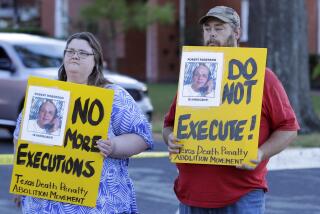Oklahoma: Witness recounts horror of botched execution
Reporting from Dallas — The lawyer watched in horror this week as an Oklahoma inmate he had come to know died a violent death during a botched execution.
The execution of Clayton Lockett on Tuesday was the first his attorney, Denver lawyer Dean Sanderford, 35, had ever witnessed.
What Sanderford saw, he told The Times afterward, was his worst fear realized: a condemned man enduring pain and suffering at the hands of the state.
“Besides the whole pain thing, I think there’s a lot that went wrong here,” Sanderford said.
Lockett, 38, was convicted of shooting a 19-year-old woman in 1999 and burying her alive. Another inmate who had been scheduled to die hours later, Charles Warner, 46, was convicted in the rape and murder of an 11-month-old girl in 1997.
Sanderford and other lawyers had objected to the executions on the grounds that Oklahoma would not disclose the source of the drugs being used to carry them out.
Their appeal was supported by a state court in March, and created substantial controversy among Oklahoma’s highest courts and elected officials.
The state was determined to execute Lockett. Gov. Mary Fallin defied the state Supreme Court’s order for a delay. A legislator sought to impeach the justices. The unusual double execution was eventually cleared to proceed, and protesters who oppose capital punishment rallied outside Fallin’s office Tuesday.
Oklahoma is one of several states that have grappled with shortages of lethal injection drugs.
Drug companies, fearful of protests, have refused to supply some of the drugs. Some states have responded by switching drugs, then declining to release information about the new drugs and who had supplied them, citing concern for the welfare of suppliers.
Oklahoma officials have defended the drugs they use.
But Sanderford said the secrecy surrounding Oklahoma’s lethal injection cocktail made it difficult to determine whether the state had violated a constitutional ban on cruel and unusual punishment.
The lawyer emerged from Lockett’s execution Tuesday deeply troubled.
He had filed into the execution observation room with a fellow lawyer and other witnesses, including reporters and corrections staff members.
Lockett’s family was not there, the lawyer said — the prisoner had asked his relatives not to come.
“He didn’t want that to be their last image of him,” Sanderford said.
The lawyer said he was later grateful for Lockett’s decision.
“It was an awful thing to witness,” he said of the procedure, likening the experience to torture.
As the execution started, Lockett was on a gurney, a sheet was pulled up to his neck, obscuring the intravenous lines that would carry the lethal drugs into his body.
A doctor sat nearby. The warden stood. A microphone was set up so that those in the observation room could hear Lockett’s last statement.
At the start of the execution, Sanderford said, “Everything looked like it was in order.”
Lockett closed his eyes. The doctor checked him. The warden announced, “Mr. Lockett is unconscious.”
That soon changed.
A few minutes later, Sanderford said, he saw Lockett start “twitching” and “mumbling” something unintelligible.
The twitching became more violent, he said, until it resembled “a seizure.”
“He was definitely writhing around. His whole upper body was lifting off the table,” Sanderford said.”What we saw was somebody coming back to consciousness.”
Soon after, the warden ordered officials to close the blinds on the window to the observers’ room, obscuring their view. The microphone in the death chamber was turned off, Sanderford said.
Reporters protested, questioning guards, who soon became agitated, he said.
Observers would not learn what had happened until they emerged from the room 10 minutes later.
“I thought they were trying to save him,” Sanderford said, “I think they realized it had gone badly wrong.”
Officials later said that Lockett died of a heart attack at 7:06 p.m.
Sanderford still wonders what happened during the roughly 25 minutes between the closing of the blinds and the announcement of Lockett’s death.
“I don’t know what happened during that period. The Department of Corrections does, but you’re never going to get it out of them,” he said.
The governor later stayed Warner’s execution, which had been scheduled to take place shortly after Lockett’s, for two weeks. A corrections spokesman said Lockett’s death would be reviewed.
Sanderford said the state should launch a broad, independent investigation into Oklahoma’s method of lethal injection.
“They need to not execute anybody else until they realize what’s going on. They need an independent autopsy by a non-Department of Corrections doctor,” he said.
He said Lockett’s execution left him “horrified.”
“It worked out exactly like we were worried it would,” he said.
molly.hennessy-fiske@latimes.com
More to Read
Sign up for Essential California
The most important California stories and recommendations in your inbox every morning.
You may occasionally receive promotional content from the Los Angeles Times.











